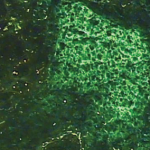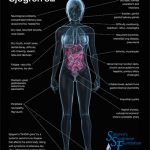NEW YORK (Reuters Health)—Sialendoscopy with irrigation of the major salivary glands can enhance salivary flow and reduce xerostomia in patients with Sjogren’s syndrome, according to a randomized trial. “In our study it is suggested that patients with recent onset of Sjogren’s syndrome and with residual salivary gland capacity could benefit from sialendoscopy,” said Dr. Derk…

Mouse Model Suggests Regulatory T Cells Play Important Role in Sjögren’s Syndrome Pathophysiology
Recent research investigated the progression and characteristics of Sjögren’s syndrome using mice engineered to lack special genome organizing AT-rich sequence binding protein-1 (SATB1). These mice proved to be a novel model for Sjögren’s syndrome and revealed T cell-dominant immune cell infiltration of the salivary glands. Over time, the frequency of B cells gradually increased, as well as the levels of anti-SSA and anti-SSB antibodies…
Ultrasound of Salivary Glands May Have Role in Diagnosing Sjogren’s
NEW YORK (Reuters Health)—Ultrasonography of the major salivary glands may have a role in the diagnostic evaluation of patients with clinically suspected primary Sjogren’s syndrome, researchers from the Netherlands report. Salivary gland biopsies and anti-SSA/Ro antibodies are important for classifying patients as primary Sjogren’s syndrome (pSS). Some studies have also supported using ultrasonography of the…
Rituximab for Fatigue & Oral Dryness in Primary Sjögren’s Syndrome
These researchers investigated whether rituximab, an anti-B cell therapy, improves symptoms of fatigue and oral dryness in patients with primary Sjögren’s syndrome (SS). The multicenter, randomized, double-blind, placebo-controlled, parallel-group trial included a health economic analysis. There were no significant improvements in any outcome measure with rituximab except for unstimulated salivary flow. The study concludes that rituximab is neither clinically effective nor cost effective in this patient population…

Clinical Guidelines for Sjögren’s Syndrome Focus on Biologics, Fatigue, Inflammatory Musculoskeletal Pain
The first clinical practice guidelines for Sjögren’s syndrome have been released, the culmination of an initiative by the Sjögren’s Syndrome Foundation.1 These standard-of-care recommendations are intended to provide consistency in practice patterns, inform coverage and reimbursement policies, lead to the design and implementation of educational programs, highlight the needs for future research and fill a…

Innate Immune Response Predicts Development of Non-Hodgkin’s Lymphoma in Sjögren’s Syndrome
The P2X7 receptor inflammasome axis may have a role in the pathogenesis of Sjögren’s syndrome and non-Hodgkin’s lymphoma. According to new research, patients with Sjögren’s syndrome who developed non-Hodgkin’s lymphoma had an increased expression of the P2X7R-inflammasome axis and the glandular expression of IL-18, suggesting a possible novel biomarker…

Sjögren’s Awareness Month: Educate Patients, Families, Caregivers
April is Sjögren’s Awareness Month, a time for rheumatologists to help educate the public and themselves about Sjögren’s syndrome and its diagnosis. With newly published clinical practice guidelines, Nancy Carteron, MD, encourages rheumatologists to be first responders for this patient population…
Recommendations for Sjögren’s Syndrome: How to Address Biologics & Musculoskeletal Pain
The clinical practice guidelines for managing Sjögren’s syndrome, developed by the Sjögren’s Syndrome Foundation with the ACR, were designed to improve quality and consistency of care. In total, 19 recommendations were agreed on, which include managing the rheumatic and systemic aspects of the disease. Recommendations include a decision tree for the use of DMARDs for inflammatory musculoskeletal pain, use of self-care measures and exercise to reduce fatigue, and the use of rituximab in selected clinical settings for oral and ocular dryness…

Research Identifies Two New Cell Types in Sjögren’s Syndrome
Two previously unidentified cellular players in the pathogenesis of primary Sjogren’s syndrome (pSS) have been discovered: a regulatory T cell (Prdm1+eTreg) and a helper T cell (Il21+Th1). In the study, researchers also identified the transcriptional signatures of these cells and their differential dependency on the lymphotoxin/LIGHT signaling axis, which may guide future therapeutic interventions…
Location & Ethnicity Affect Manifestations of Primary Sjogren’s Syndrome
NEW YORK (Reuters Health)—Geolocation and ethnicity exert a “strong influence” on the phenotype of primary Sjogren’s syndrome, researchers report. “The influence of ethnicity on the phenotypic expression of systemic autoimmune diseases has been suggested by various studies, especially in systemic lupus erythematosus, which has been reported as being more frequent and having less favorable outcomes…